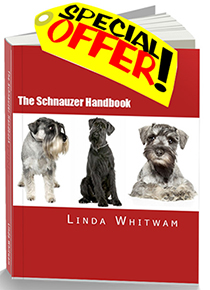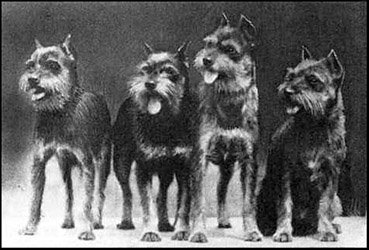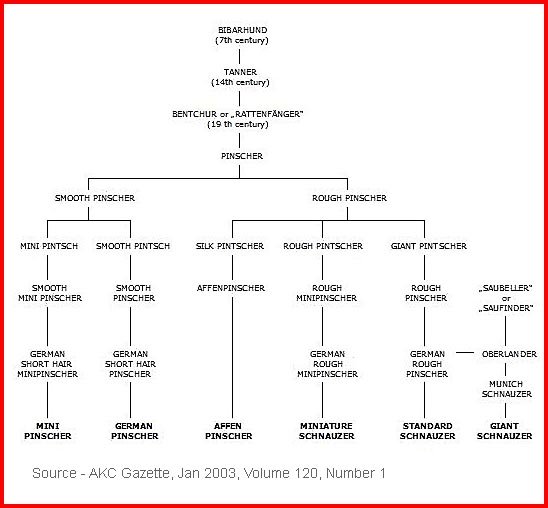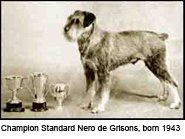|
Schnauzer HistoryMany Theories There is no precise written record of Schnauzer history. Over the years, dog breed experts have discussed many theories but nobody knows exactly how and when the Schnauzer was created. Many ill-informed articles appear on other websites. After much research covering many sources, here is the most credible version of the true Schnauzer history - Story of The Schnauzer The Schnauzer originated in Southern Germany in the 14th or 15th century. In those days tradesmen and farmers travelled the countryside with heavily laden carts selling their goods and produce at markets. They needed a medium size and versatile dog which would be strong enough to guard the cart, but small enough to easily fit in that same cart. These practical men also wanted a good ratter to keep down the vermin back at home.
The breeders involved in Schnauzer history probably crossed the black German Poodle and the gray Wolfspitz with more than a pinch of Wire-haired Pinscher (aka Rough Pinscher) to create the first Schnauzer. This medium-sized 'prototype' most closely resembled today's Standard Schnauzer and established the breed as a working dog. Schnauzers in Art There is a statue in Mecklenburg, Germany, dating from the fourteenth century of a hunter with a Schnauzer crouching at his feet. The Schnauzer again appears in a 1620 statue called "The Night Watchman" in Stuttgart, Germany. It's a fact that the breed also featured in several paintings by Albrecht Durer (1471-1528). He probably owned a Schnauzer himself, as he made several paintings of what looks like the same dog at different stages of its life. A tapestry from 1501 called Crown of Thorns - by Lucas Cranach the Elder - also contained a dog looking suspiciously like a Schnauzer. Other famous artists, such as the Dutch master Rembrandt (17th Century) and English painted Joshua Reynolds (1723-1792) also painted Schnauzers. Origin of the Name The word Schnauzer should be pronounced "sh-now-tser" with the German Z sounding like TS - as in Mozart, which is spoken "Motsart." It comes from the German word "Schnauze" meaning snout. This obviously refers to the wonderful whiskers on the muzzle which are the trademark of all Schnauzers and give them such an unforgettable look. Wire-haired Pinschers In the early days of Schnauzer history in Germany, the first Schnauzers as we know them were referred to as Wire-haired Pinschers. At the 3rd German International Show in 1879, three Wire-haired Pinschers, owned by C. Berger from Wurtemburg, were entered. The winner was a dog called "Schnauzer". From then on, all dogs of this breed were called Schnauzers. The Schnauzer History family tree, shown below courtesy of the AKC, outlines the different dog breeds used to develop the three types of Schnauzer:
The original smooth coated Pinschers were bred with each other to give the sleek coat of today's Miniature and Doberman Pinschers. The wire haired Pinschers were were specifically bred to give the rough coat of modern Schnauzers. Returning Soldiers In the mid-19th century, German dog breeders began to show an interest in this versatile native breed. At this time, the medium-sized dogs were also being crossed with other breeds to create the Miniature and, later, the Giant Schnauzer. Although there may have been an odd one imported earlier, the first Schnauzers were brought into the UK and America around 1900. They were probably brought to England and the New World as beloved pets of immigrant families as well by travellers and traders returning home. During World War I, Standard Schnauzers were used as guard dogs by the German Army and dispatch carriers by the Red Cross.
Miniature Schnauzer History The Miniature Schnauzer was exhibited as a distinct breed at early as 1899. It's thought to have been derived from breeding the smallest of the Standard Schnauzers with Affenpinschers, gray Spitz, and black Poodles in a highly selective breeding program. Four Miniatures imported by Mrs. M. Slattery of the Marienhof Kennels in 1924 were the foundation stock for the breed in America. Miniature Schnauzers were first registered as a separate breed in 1926. The following year the first American champion was Mrs. Slattery’s Ch. Moses Taylor. This was an honor shared with Don v. Dornbusch, since both won on the same day - but at different shows. Since then the Miniature Schnauzer’s popularity has soared elevating the dog to one of the most popular breeds in America.
Giant Schnauzer History The Giant Schnauzer was the last of all three breeds of Schnauzer to be created. In Germany the "Riesenschnauzer" (which literally means Giant Snouter in German!)was initially bred and used to drive cattle and sheep. It was also used as a guard dog. In the 1928 book on German dog breeds, E. von Otto says the father of the Giants was the great "bear Schnauzer" of Munich.This was a dog breed with long shaggy hair related to the Old German shepherd dog. This was probably crossed with the black Great Dane, giving strength and power to the Giant, as well as the instinct to protect. Von Otto also wrote: "in his general appearance and wonderful nature he bears a very strong resemblance to the Bouvier des Flandres." This was another dog breed developed to drive cattle, but whose intelligence, strength and versatility have been put to many uses since then. The Odivane Kennel of Mary Moore was one of the first importers of Giants into the UK, whilst the breed was imported into the USA in the 1930's. However, until the 1960's there were still less than 50 Giant Schnauzers a year registered in America. With selective breeding and importing from successful kennels as well as word of mouth endorsements of the breed, the popularity of the Giant Schnauzer has increased considerably over the last 40 years. To learn much more about the 3 different types of Schnauzer, follow these links -
Schnauzers - Hypoallergenic and Non-Shedding Dogs
|
AVAILABLE ON AMAZON AS PRINTED BOOK AND KINDLE! The definitive manual for owners of Miniature Schnauzers, Giants and Standard Schnauzers

"The Schnauzer Handbook is brilliant and covers almost all you want to know about the breed," Michele L, Bournemouth
"A thoroughly interesting and entertaining book. There’s hardly anything about schnauzers that isn’t in here - it even made me smile!" J. Garrard, Ormond Beach, Florida






 It's interesting that although they look nothing alike now, the modern Schnauzers and Pinschers share the same ancestors.
It's interesting that although they look nothing alike now, the modern Schnauzers and Pinschers share the same ancestors. 